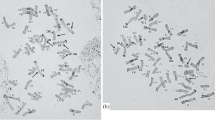Abstract
The degree of sterility resulting in F1 hybrids has been used by several workers while considering the relative affinity between the different varieties and sub-species within a species and that between different species. The authors contend that sterility cannot be used as a criterion and present spikelet sterility data in F1 hybrids of inter-varietal, inter-subspecific and interspecific crosses in the cultivated rices to support this contention. They conclude that the evolution of the three sub-species (viz., japonica, javanica and indica) may have taken place independent of each other from the various ecotypes of the putative species Oryza perennis through introgression although the possibility of the indica giving rise to japonica on the one hand and the javanica on the other cannot be altogether ruled out.
The consequences of such a mode of evolution are discussed and the possibility of the existence of a slightly different set of linkage groups in indica rices compared with that of japonica rices is suggested.
Similar content being viewed by others
References
Govindaswamy, S., & Krishnamurty, A., On the occurrence of japonica type of grains in Jeypore tract. Rice News Teller 6: (4): 22–24.
Kato, S. et al, 1928. On the affinity of rice varieties as shown by the fertility of the hybrid plants. Gakugeizasshi 3: 132–147.
Kato, S., 1930. On the affinity of cultivated varieties of rice plants, Oryza sativa L.. J. Dept. Agric. Kyushu Imp. Univ. 2: 241–276.
Kihara, H., 1952–53. Peoples of Nepal. Himalaya scientific results of the Japanese Expedition to Nepal Himalaya. Vol. III. Fauna & Flora Research Society Kyoto Univ., Kyoto, Japan, pp. 398–400.
Mishra, R. K., & Misro, B., 1960. Observations on interracial crosses of rice. II. Inheritance of semi-sterility. Bihar Univ. Journ. (In press).
Morinaga, T., 1934. Cytological studies on Oryza sativa L.. Jap. J. Bot. 7 (1–2): 74–106.
Morinaga, T., 1954. Classification of rice varieties on the basis of affinity. Report V Meeting Working Party on Rice Breeding. In: Studies on rice breeding. Sep. Vol. of Jap. J. of Breeding 4: 1–14.
Nagai, I., 1959. Japonica rice. Its breeding and culture. Yokendo Ltd., Tokyo. 843 pp.
Richharia, R. H. & Misro, B., 1959. The japonica × indica hybridization project in rice — An attempt for increased rice production. J. Biol. Sci. 3 (2): 35–47.
Richharia, R. H., 1960. Origin of cultivated rices. Indian J. Genet. & Pl. Breed. 20 (1): 1–13.
Richharia, R. H., & Misro, B., 1961. Evolutionary tendencies in rice based on genetic evidence. Proc. Nat. Inst. Sci. (In press).
Sampath, S., and Mohanty, H. K., 1954. Cytology of semi-sterile hybrids. Curr. Sci. 23: 221–222.
Wagenaar, G. A. W.; Schouwenburg, J. Ch. van and Siregar, H., 1952. Semi-sterility of rice hybrids in Indonesia in relation to the indica-japonica problem. Contribution of the General Agricultural Research Station, Bogor. No. 127: 1–21.
Author information
Authors and Affiliations
Rights and permissions
About this article
Cite this article
Richharia, R.H., Misro, B. & Rao, R.K. Sterility in the rice hybrids and its significance. Euphytica 11, 137–142 (1962). https://doi.org/10.1007/BF00033785
Received:
Issue Date:
DOI: https://doi.org/10.1007/BF00033785



